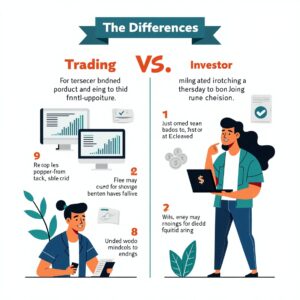Absolutely! Here’s a detailed 4,000-word article titled:
Quick Guide: Trading vs Investing – What You Need to Know

Introduction
When it comes to building wealth in the financial markets, two common strategies dominate the landscape: trading and investing. Though they both aim for financial growth, the approaches, timelines, risk profiles, and psychological demands differ significantly. Whether you’re a beginner looking to understand your options or someone considering a shift in strategy, understanding the distinction between trading and investing is crucial.
In this comprehensive guide, we will explore the key differences, advantages, risks, tools, time commitments, and psychological traits associated with each. By the end, you’ll have a clear sense of which path—or combination of both—aligns best with your goals, resources, and risk tolerance.
1. Defining the Basics
What is Trading?
Trading refers to the frequent buying and selling of financial instruments such as stocks, commodities, currencies, or derivatives with the goal of making short-term profits. Trades can occur over seconds (scalping), minutes, hours (day trading), or a few days to weeks (swing trading).
Key Characteristics:
- Short-term horizon
- Profit from price fluctuations
- High activity and engagement
- Involves technical analysis and timing
What is Investing?
Investing, on the other hand, involves purchasing financial assets with the intention of holding them over a long period—often years or decades. The objective is to grow wealth gradually through appreciation, dividends, or interest income.
Key Characteristics:
- Long-term horizon
- Focus on fundamentals
- Emphasis on compound growth
- Requires patience and strategic planning
2. Time Horizons: Short-Term vs Long-Term

Trading: Fast-Paced and Time-Sensitive
Traders thrive on volatility. A single news event can lead to major price swings, which traders capitalize on. They monitor markets closely, often using real-time charts, indicators, and trading platforms to execute rapid decisions.
- Scalpers may open and close dozens of trades per day.
- Day traders close positions before the market closes.
- Swing traders may hold positions for a few days to a few weeks.
Investing: Slow and Steady
Investors look at the bigger picture. They focus on long-term economic and business trends, often holding stocks through market cycles, including downturns. The philosophy is rooted in buying solid companies and letting them grow over time.
- Investment horizon often ranges from 5 to 30+ years.
- Focus on dividends, reinvestment, and compound interest.
3. Risk and Reward Profiles
Trading: High Risk, High Reward
Trading involves high exposure to market volatility, which can result in substantial gains or losses in a short time. Success often depends on precise execution and risk management.
Risks:
- Quick losses due to market swings
- Leverage amplifies gains and losses
- Emotional stress can lead to mistakes
Rewards:
- Potential for fast profits
- More opportunities daily or weekly
- Flexibility and liquidity
Investing: Lower Risk, Long-Term Reward
While investing still carries risks—especially during market downturns—it tends to be less volatile due to the longer horizon and diversified portfolios.
Risks:
- Market downturns can affect portfolio value
- Inflation can erode returns if not managed
- Overconfidence in long-term returns
Rewards:
- Compound interest works over time
- Historically strong returns in equity markets
- Potential for passive income through dividends
4. Tools and Techniques
Trading Tools
Traders rely heavily on technical analysis, charts, indicators, and fast execution platforms.
Common tools include:
- Trading platforms (e.g., MetaTrader, Thinkorswim)
- Technical indicators (e.g., RSI, MACD, Bollinger Bands)
- Real-time news feeds
- Price action strategies
- Risk management systems (e.g., stop-loss, take-profit)
Investing Tools
Investors focus on fundamental analysis—the health and growth potential of companies or assets.
Common tools include:
- Financial statements (income, balance sheet, cash flow)
- Key ratios (P/E, ROE, debt/equity)
- Broker research reports
- Economic indicators (GDP, inflation)
- Portfolio management software (e.g., Morningstar, Seeking Alpha)
5. Mindset and Psychology

Trading Psychology
Traders need a high level of discipline, quick thinking, and emotional control. Overtrading, greed, and fear are common pitfalls.
Key Traits:
- Comfort with uncertainty
- Ability to act quickly and decisively
- Resilience after losses
- Analytical and emotionally detached
Investor Psychology
Investors benefit from patience, consistency, and a long-term vision. They need to stay the course during market dips and avoid panic selling.
Key Traits:
- Long-term commitment
- Belief in business fundamentals
- Discipline to rebalance
- Avoidance of herd behavior
6. Capital Requirements
Trading
- Often requires a significant upfront capital for margin accounts or short-selling.
- Pattern day trading rules in the U.S. require a minimum of $25,000 for active day trading.
- High transaction costs and commissions can eat into profits.
Investing
- More accessible with small capital amounts.
- Options like ETFs and fractional shares make it easy to diversify.
- Low-frequency trading means lower fees over time.
7. Tax Implications
Trading
- Profits are generally taxed as short-term capital gains, often at higher income tax rates.
- Requires meticulous record-keeping of each trade.
- Some may qualify for trader tax status in certain jurisdictions.
Investing
- Long-term capital gains are taxed at a lower rate if held over a year.
- Dividends may be taxed favorably.
- Tax-advantaged accounts like IRAs or 401(k)s help minimize liabilities.
8. Learning Curve and Education

Trading: Steep and Ongoing
Traders must constantly adapt to market changes, strategies, and new tools. Education is ongoing and involves both theory and practical experience.
- Requires learning charting, indicators, and risk control
- Demo trading is essential before risking real capital
- Mentorships or paid trading communities are common
Investing: Broad but Steady
Investors benefit from understanding macroeconomics, industry trends, and company fundamentals. Education can be slow and deliberate.
- Read books like The Intelligent Investor or Common Stocks and Uncommon Profits
- Follow market news, annual reports, and economic data
- Passive strategies like index investing are easier for beginners
9. Popular Strategies
Trading Strategies
- Scalping: High-frequency trades, small profits per trade
- Day Trading: Intra-day trading using momentum or news catalysts
- Swing Trading: Short-term trend-based trades
- Position Trading: Longer-term trades based on major trends
Investing Strategies
- Buy and Hold: Long-term holding of quality stocks
- Value Investing: Buying undervalued stocks with growth potential
- Growth Investing: Focusing on companies with high growth rates
- Dividend Investing: Targeting companies with consistent dividend payouts
- Index Investing: Investing in market indexes like the S&P 500
10. Which One Is Right for You?
Ask Yourself:
- How much time can you dedicate daily?
- Trading demands hours; investing can take minutes a month.
- What’s your risk tolerance?
- Trading is high-risk; investing is moderate to low risk.
- Are you emotionally resilient?
- Traders must handle losses without panic.
- Do you want active income or passive growth?
- Trading aims for regular income; investing builds long-term wealth.
- Do you enjoy technical analysis or reading business fundamentals?
- Traders live on charts; investors read financial statements.
11. Combining Both: A Hybrid Approach
Many modern market participants use a hybrid approach:
- Invest 80% of your capital long-term in diversified portfolios.
- Use 20% for trading opportunities in volatile sectors.
- This balances stability with excitement and opportunity.
Conclusion
Trading and investing are both valid paths to wealth but require different mindsets, tools, and time commitments. Trading can be lucrative and exciting but demands skill and discipline. Investing is more forgiving and has a longer track record of success through the power of compounding.
Choose your path based on your goals, risk profile, and lifestyle. Better yet, educate yourself about both—understanding the strengths and weaknesses of each can help you navigate the markets with confidence and clarity.